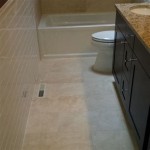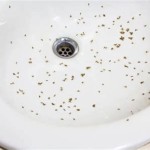Can You Tile Over Tiles In A Bathroom: A Comprehensive Guide
The possibility of tiling over existing tiles in a bathroom presents an appealing solution for homeowners seeking to renovate without incurring excessive costs and labor. While it can be a viable option, a thorough evaluation of several factors is necessary to determine its suitability for a specific bathroom remodeling project. This article provides a comprehensive guide to assess the feasibility of tiling over existing tiles, outlining key considerations and best practices to ensure a successful outcome.
Tiling over existing tiles can reduce demolition time and disposal costs significantly. Removing old tiles is a labor-intensive process, often requiring specialized tools and protective gear, and generating considerable dust and debris. Furthermore, disposal of removed tiles can incur fees at landfills or recycling centers. Installing new tiles directly over the existing surface circumvents these challenges, streamlining the renovation process and decreasing the overall project timeframe. By avoiding demolition, the structural integrity of the underlying substrate, such as the subfloor or wall studs, remains undisturbed, minimizing the risk of accidental damage and associated repair costs. This method is particularly beneficial in older bathrooms where asbestos-containing materials may be present in the original tile or adhesive, as it avoids disturbing these hazardous components. However, it is crucial to ascertain the absence of asbestos through professional testing before proceeding.
The financial benefit of tiling over existing tiles stems from the reduced labor costs and material expenditure. Demolition and disposal typically account for a substantial portion of a bathroom renovation budget. By eliminating these steps, homeowners can allocate resources to higher-quality tile materials, improved fixtures, or other aspects of the remodeling project. The need for new backer board or underlayment may also be avoided if the existing tile surface is adequately stable and level. Furthermore, the project's overall timeline is shortened, resulting in further savings on labor expenses. However, careful consideration should be given to the cost of surface preparation materials, such as bonding agents and self-leveling compounds, which are essential for ensuring proper adhesion and a smooth, even surface for the new tiles.
While the advantages are clear, successful execution depends on a meticulous assessment of the existing conditions. Ignoring potential problems can lead to costly rework, compromised aesthetics, and even structural issues in the long term. The stability, levelness, and condition of the existing tiles are paramount. Proceeding without addressing underlying issues will only transfer those problems to the new tile layer, resulting in an unsatisfactory and potentially unstable finished surface.
Assessing the Condition of the Existing Tiles
The initial step in determining the viability of tiling over existing tiles is a thorough inspection to assess their condition. This involves identifying any loose, cracked, or damaged tiles. Loose tiles indicate a failure of the original adhesive, which can compromise the integrity of the entire surface. Cracked tiles can be indicative of underlying structural issues or improper installation techniques. Damaged tiles, such as those with chips or gouges, can hinder the proper adhesion of the new tiles and create an uneven surface.
Each loose or damaged tile must be addressed before proceeding. The removal of loose tiles is necessary, followed by cleaning the exposed substrate and patching any voids or imperfections with a suitable cement-based repair mortar specifically designed for tile setting. This ensures a solid and level base for the new tiles. Cracked tiles should be removed and replaced with new tiles matching the existing ones in size and thickness to maintain a uniform surface. If a large number of tiles exhibit damage, it may be more cost-effective and structurally sound to remove the entire existing tile surface and install new backer board or underlayment.
In addition to the condition of individual tiles, the overall levelness of the existing surface needs to be evaluated. Significant variations in height between tiles can create an uneven surface that is difficult to correct with thin-set mortar alone. A long level or straight edge should be used to check for any dips, humps, or undulations across the tile surface. Minor imperfections can often be addressed with self-leveling compounds, but more significant discrepancies may necessitate the removal of the existing tiles.
Furthermore, the type of existing tile plays a role in determining the suitability of tiling over them. Smooth, glossy tiles may not provide adequate adhesion for the new tile layer. In such cases, surface roughening techniques, such as sanding or the application of a bonding agent designed for non-porous surfaces, are crucial. Porous tiles, such as natural stone or unglazed ceramic, generally offer better adhesion, but still require proper cleaning and preparation to remove any contaminants that could interfere with the bond.
Preparing the Existing Tile Surface
Proper preparation of the existing tile surface is critical for ensuring a strong and durable bond with the new tile layer. This involves a series of steps, beginning with thorough cleaning to remove any dirt, grease, soap scum, or other contaminants. A heavy-duty cleaner specifically formulated for tile and grout should be used, followed by a thorough rinsing with clean water. Stubborn stains or residue may require scrubbing with a stiff brush or the use of a specialized cleaning solution.
After cleaning, the existing tile surface should be sanded to create a slightly rougher texture that promotes adhesion. A medium-grit sandpaper or a diamond sanding pad can be used for this purpose. The sanding process should be performed evenly across the entire surface, paying particular attention to smooth or glossy tiles. Care should be taken to avoid damaging the underlying substrate during sanding. After sanding, the surface should be thoroughly vacuumed to remove any dust or debris.
The application of a bonding agent is a crucial step in preparing the existing tile surface for tiling over. A bonding agent is a liquid primer that creates a chemical bond between the existing tiles and the new thin-set mortar. It is especially important when tiling over smooth or non-porous surfaces. The bonding agent should be applied according to the manufacturer's instructions, ensuring even coverage across the entire surface. Some bonding agents require a specific drying time before the thin-set mortar can be applied. Allowing the bonding agent to dry completely is crucial for achieving optimal adhesion.
In situations where the existing tile surface is uneven, a self-leveling compound may be necessary. Self-leveling compounds are cement-based mixtures that are poured onto the floor and spread evenly to create a smooth, level surface. They are available in various formulations designed for different levels of unevenness. The self-leveling compound should be applied according to the manufacturer's instructions, ensuring proper mixing and application techniques. The drying time for self-leveling compounds can vary, so it is important to allow sufficient time for the compound to cure completely before proceeding with the tile installation.
Addressing Potential Challenges and Considerations
Several potential challenges and considerations should be addressed before tiling over existing tiles. One of the primary concerns is the added thickness of the new tile layer, which can affect door clearances, plumbing fixtures, and floor transitions. Doors may need to be trimmed to accommodate the increased floor height. Plumbing fixtures, such as toilets and vanities, may need to be raised to maintain proper functionality. Floor transitions between the bathroom and adjacent rooms may require the installation of transition strips to create a smooth and safe walking surface.
The weight of the new tile layer is another important consideration, particularly for floor installations. The existing floor structure must be able to support the additional weight without risk of deflection or failure. A structural engineer may need to be consulted to assess the load-bearing capacity of the floor and ensure that it meets building code requirements. If the existing floor structure is inadequate, reinforcement may be necessary before proceeding with the tile installation.
Changes to the bathroom layout or design may necessitate the removal of some or all of the existing tiles. If the new tile layout differs significantly from the existing one, the exposed substrate may need to be prepared with new backer board or underlayment. Furthermore, if plumbing fixtures are being relocated, the existing tile surface may need to be patched or modified to accommodate the new plumbing lines.
Another critical consideration is the impact on the existing waterproofing system. Tiling over existing tiles can compromise the integrity of the waterproofing membrane beneath the original tile layer. If the existing waterproofing system is damaged or ineffective, it may be necessary to install a new waterproofing membrane over the existing tile surface before proceeding with the tile installation. This is particularly important in shower areas, where water penetration can lead to significant damage and mold growth.
Finally, compliance with local building codes and regulations is essential. Some jurisdictions may have specific requirements regarding tile installation, waterproofing, and structural load-bearing capacity. It is important to consult with local building officials to ensure that the proposed tile installation meets all applicable codes and regulations.

How To Tile Over Existing Brepurposed
Faq Can I Tile Over Existing Tiles Ifixit

How To Tile Over Existing Brepurposed

Can You Tile Over In A Bathroom The Seattle Times

How To Tile Over Existing Brepurposed

How To Tile Over Tiles And Save Time Money

Tiling Over Tiles Avoiding The Unknown Bathroom Guru

How To Tile Over Existing Brepurposed

Can I Tile Over Old Tiles In My Bathroom Ask The Experts Victoriaplum Com

Can You Put Bathroom Wall Panels Over Tiles Igloo Surfaces
Related Posts







